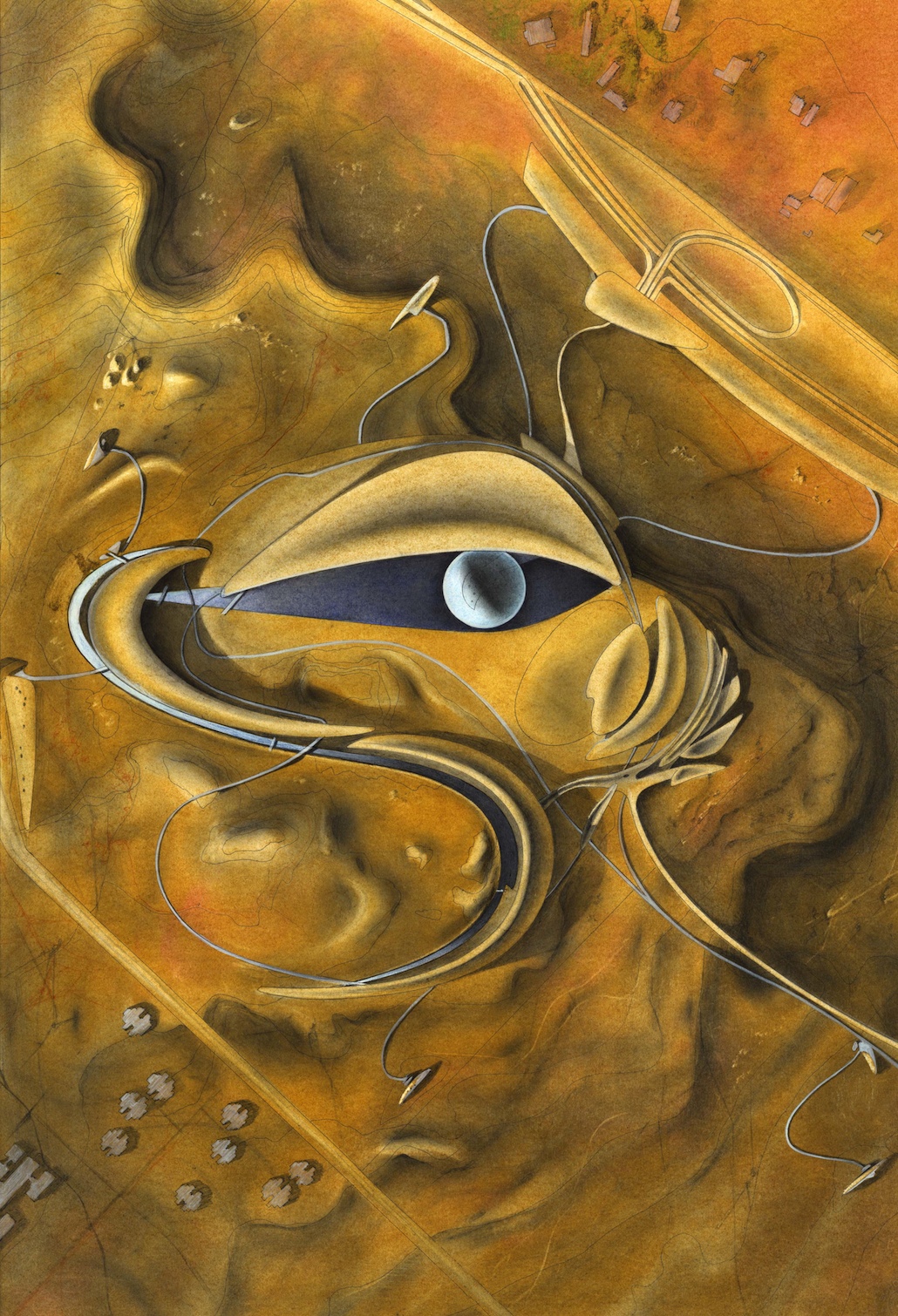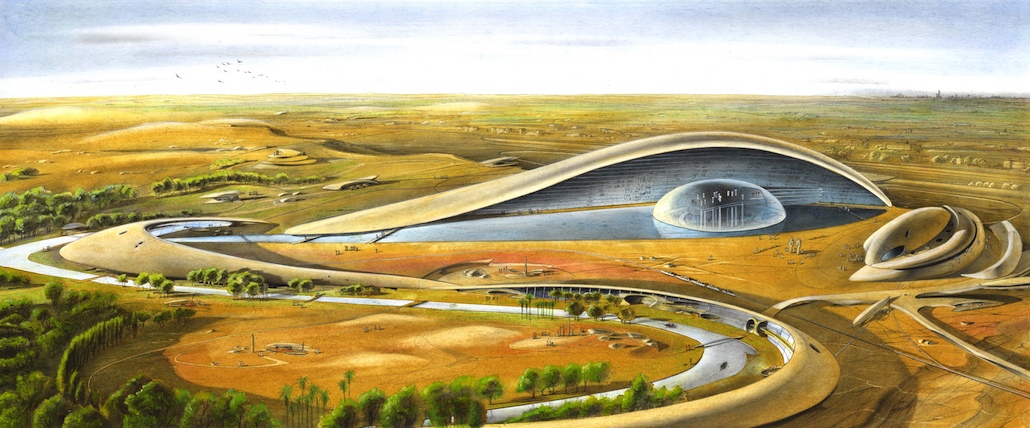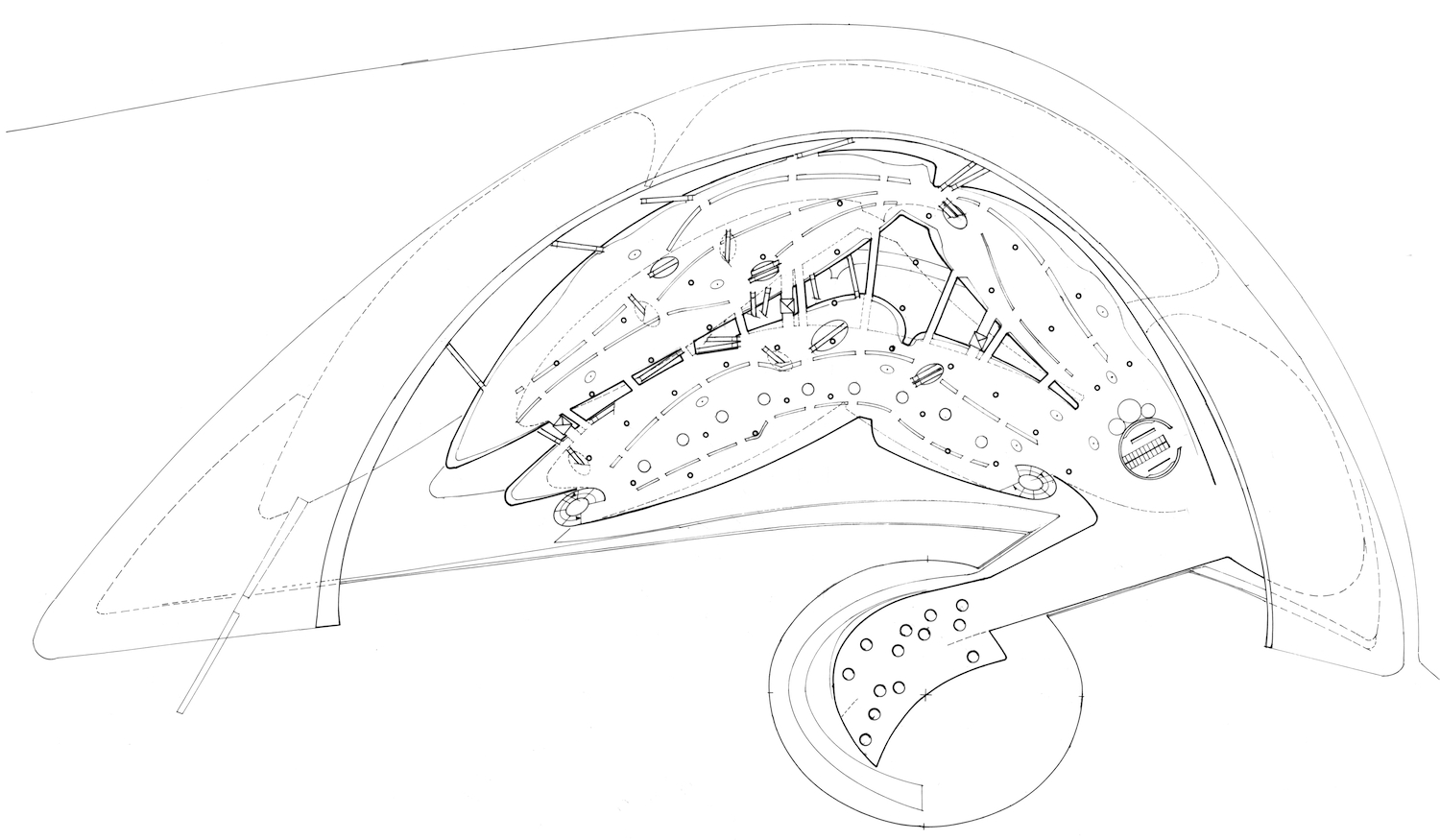

Earth's Habitat Change
Pouchulu architect
8 - Architectural Actions: Re-Balance
Our mission is to create innovative architectural projects that both anticipate and recover. Anticipate new forms of living... recover old ways of living. This apparent paradox, not easy to observe, is in the core of our Organic approach. There are ancient essential archetypes that link us with Nature, ways of understanding life that should not change: gathering around a fireplace, a dinner table, cooking our own meals. A small corner desk to write personal letters. A bookshelve, a library. Gathering with friens at home, getting closer, sharing a good conversation, looking at the sky at night, pointing our eyes towards the horizon in a long perspective in the "cold light of the morning", feeling the wind and garden flavours in spring, winter, summer and fall... Aphrodite's Child. These archetypes must be kept but re-visited with new forms (programmes) and spatial relations. The whole universe of Frank Lloyd Wrigth is about this. But if they start to disappear... architecture becomes meaningless. That tacit void, difficult to describe in words, is what has been stressesing life at the end of the 20thC. and beginning of the 21thC. It is not new. Every age and time has its own particularities. Our void was created when we started to sit in front of a TV set, then a computer, then a video-game, now a mobile phone.
What we used to consider as 'desirable environment', can easily shift towards psychologial nightmares. Science fiction in literature, since 1870 onwards, created the illusion that the future could solve certain human limitations, and it was fun. But soon in science fiction movies (1930 in the USSR, Germany, later in the US and UK) writers and directors, in between the Wars, escaped from reality and started to imagine possible, idealistic futures where forms are based on a hopeless trust in a better, scientific future. Thank God many of those brilliant directors like Fritz Lang or Ridley Scott were very aware that the differnce between a pleasant dream and a nightmare is very thin.
Like any aesthetic movement, it had deep implications in real life. What a few noticed was that many, if not all proposed solutions for everyday's life did not -and do not- requiere sohphisticated technical solutions. Habitat does not need electronic or digital technology. We seem to be trapped in a strange corner: a disconnected virtual world that promises to solve problems we really do not have. Most electronic and digital based devices are expensive toys that do not apply to reality and pollute. Nothing is less "smart" than a "smart house" or "smart technology". An intelligent washing machine? A simple name applied to a fully dependent digital-based surveillance home infrastructure, that has to be constantly updated, and highly contaminant. Clearly, a form of commercial slavery for services we do not need. Permament advertising can become very effective, it works both in business and in politics, ending in a pre-trance mode. Modern humanity replaced religion for consumerism.
What is our proposed re-balanced Habitat? Not only reducing pollution, applying a circular economy, understanding there is no symetry in imperfect -or very complex- "circular" concept, at least not in a linguistical way, because reality is not in equilibrium: it is moving, changing, permanently balancing on itself. Germany is working well in that matter, I recall the great work of my friend engineer Patrick Teuffel.
To recover some of our Romantic landscape and lifestyle abandoned in the 19th Century we should think in a radical change of industrial production parameters. It is not going back, which is possible only in literature, films or dreams. Rather than stopping the use of current fossil energy sources, oil and gas, which is impracticable, we must start optimising industries, reducing the use of unneficcient power production systems, and recycling all we can. The Earth will balance itself.
Presently, as mentioned many times in this book, we should stop the madness of the obsolet power generation and electricity transport, developed in the late 19th Century and expanded for 150 years. High Voltage lines are needed because electricity must be transported along thousand of kilometres, but 40% of it is lost, plus another 10% by using transformers to plug our low voltage home appliances in 220 or 110 Volts (energy dissipated as heat). Subject I discussed with former Philips CEO Franz van Houten back in 2012, which is one of the fundamental aspects of Cyclotel Network. Once we develop a power generating system that is clearly more economical than what is currently offered, not only people will emigrate but also power companies will start moving into the new concept. Wires and hevay transformers are replaced on a regular basis anyway, so the complete migration to the house-by house power generation could take 15 to 30 years.
The infrastructure fed by oil and plastic-related industries must be re-designed and re-developed. Home fittings and furniture, emulating wood (fake wood, even sometimes called "Eco leather"! must be halted. Ordinary citizens must realise that the only sustainable and ecologial source of materials is vegetal and animal. Oil industry can imperonate almost any material but its manufacture process is penicionus.
There is no indication that such decisions are being considered. The existing industrial process contaminates, glues, compounds, mixing and all the line tends to be harmful. Even the majority of cotton and wool is artificial... made of different types of plastic. Microplastics is a serious issue. In our loungs, in the air, in land and ocean. Just by getting back to natural fibers, I will point what ended up called as "Carbon foot print" and diverted the discussion, is present in the extraction (30%), production (40%), transportation (20%) and advertising (10%). If we use vegetal and animal materials for our clothing and furniture and fittings, there will be no extraction, just collection, which involves a fraction of pollution even with oil engines. The same with production. Transportation will remain the same, but can be optimised with trains and bikes, and there is (really) no need of advertising... we an still promote everything on papers (newspapers, magazines, briefs). Internet is making life unsustainable. It is the other way round. If we use trees for burning and heating homes, we will not new CO2: we put on the air the amount of carbon that three absorved during its life. If we chop down one tree, and plant many, our habitat is rebalanced. Forest and jungles are decarbonisation machines during the day, and oxigenation machines at night. photosynthesis is a marvelous process. There is no need of creating any decabornisation machine. We must plant billions of trees.
I will mention my Grand Egyptian Museum project; pictured below in the bird's eye perspective, as an example of a massive building of 280 metres width and 30 metres high that solves its energy needs with passive air circulation. The shell, made of light metal bars covered by a thin layer of light concrete of 3 inches and covered with five multi-insulation layers made of fibers, takes the extreme sun heat and transforms it in cool air, working as a heat pump. This is achieved by interchanging the cool air stored underneath the whole building in serpentine cooling "caverns", in contact with the cool sand underground. The large glass window that faces the Giza pyramids reflects the sun light towards the artificial lake, that also acts as a heat interchanging device. A series of automatised screens and flaps moved by gravity control the air movement within the shell, allowing the permanent cooling during the day and releasing the excessive heat at night. The building produces all its energy, distributed as LV (low voltage) and, during the day, a series of strategically located mirrors introduce sun light to every single corner in the four levels; most of this mirrors are located within the large front courting wall. Columns, walls, and cantilever platforms are made of a light organic protruded plastics and wood structures filled with small spheres, which are finally wrapped with super-light sandy-concrete. Because of corrosion, cost and limited durability, there is no steel as structure. This sort of solution shows that a complete new approach to construction is needed.

Pouchulu's Grand Egyptian Museum, Giza, Egypt, 2002. The largest museum of Egyptology, laying in an extreme environment, where temperatures would reach the unbearable, but still we would be able to inhabit the interior, thought as a thermal converter where interchanging heat pumps between the cool sandy underground and the hot exterior will provide electricity and air natural air conditioning. The destiny of the populated Giza and Cairo is another subject. Black pencil, coloured pencil, oil and pastel on glossy paper.
Passive energy was solved in the mid-sixties, with many successful examples built in the US, the UR.S.S., the UK, Germany, Argentina, France. A school with minimum or at time no needs of electricity. Was it because of lack of curiosity? Laziness? The extraordinary mainstream in passive energy research in new building techniques that started in 1945 lasted till 1975. It was abandoned. Unfortunately, what is today seen as ecological, it is not. The industry has evolved without the participation of architects. As a result, our old integrationist vision has vanished. Most engineers -apart from my friend Nick Maclean- cannot understand the nature of materials and structures; the art of construction has been today replaced by the fascination of so called "smart" concepts, which is plain marketing tricks to install more and more complicated elements, designed, manufactured and installed with expensive materials and electrically-monitored devices. In general, in architecture we do not need that. In our houses, levers are enough, and for institutional architecture, bigger levers, bars and counter-weight mechanisms can move, translate, open or close any type and size of windows, doors, panels, roofs or platforms. Cavity walls work perfectly well. There is nothing wrong in bricks and cement, if it will last a hundred years. If we need electricity, the elements of Nature and its capacity for producing and storing energy should become our ally: passive heat-cold differences, wind, water, and, most particularly, the forgotten gravity.

Pouchulu's Grand Egyptian Museum, Giza, Egypt, 2002, bird's eye perspective from Giza's pyramids. Black pencil, coloured pencil, oil and pastel on glossy paper.
In a larger perspective there is much we can do to stop pollution. We produce loads of rubbish. Imagine a cubic hectare: 100 by 100 by 100 metres. Now imagine that volume times 10.000. This is about the volume of rubbish we put into the ocean, every year. One third of it sinks, the other third floats within, and the remaining third ends up floating on the surface, forming an artificial floating island in the Pacific Ocean, between the US and Japan, closer to the former, that has now reached the size of 10 countries like France: plastics, bottles, washing machines, plastic recipient boxes. fishing nets, every single object that ends in rivers and then to the sea goes there after months or years. Billions of people throwing away things in the toilet, streets, streams, rivers and lakes, all ends up in the Ocean. The UK and France (apparently Russia did not) have been burying thousands of nuclear waste barrels in the bottom of the ocean, it is not difficult to imagine the fast corrosion of those precarious concrete casks, under water pressure: as a result, in a few decades radiation will conquer the ocean, and finally Godzilla will become a reality. The acidification of the sea was alerted by Jacques-Yves Cousteau back in the seventies; he insisted, and for decades, that once the ocean is dead our civilisation will die, because half of the Earth's oxygen is produced by Phytoplankton, in the ocean. By 2025 a third of it was apparently gone. We are getting there. We keep buying groceries packed in hard plastics, artificial cotton, plastic toys, balls and merchandising, everything directly produced by the oil and chemical industry, and those objects stay with us not even years (clothing) but weeks (shampoo bottles), hours (food packaging) or even minutes (sweets, chocolate, cigarette packaging). All used to be wrapped in paper, now is made of fake paper, plastic stuff. Fierce advertising and marketing has installed the idea that wood, leather, cotton or any kind of natural fibre is expensive, old fashioned, and not ecological, when in reality is the other way round! Those are the basic materials to manufacture most of our objects of every-day use. Except, of course, those related to industry: medicine, aeronautics, machines or space research, that require plastic-based products. Architecture and Habitat are not machines nor do they need them.

Pouchulu's Grand Egyptian Museum, Giza, Egypt, 2002, first level plan. Black ink on film.
Architects are unable to cast a spell on themselves, and wake up.
We cannot make things bigger or paint them red "so they can be seen". Or use translucent walls because it looks "cool" in the screen, following neither architecture languages nor any rational system for constructing significant and symbolic spaces. Geometry has a meaning. Order exists. In the last century architecture had become as a Mary Celeste: minimlist pictures in magazines, sort of naked world, with no people in the photos. Advertising. Good quality pictures, but started the process of de-humanisation. In this one, it became a shipwreck. Have you watched Playtime by Jacques Tati? Please stop reading this, try to find it and do so.
Rather than re-define what kind of architecture is needed, what kind of world we want to live in, it looks like we should first decide if we want to survive. If yes, then we should redirect our efforts into a different direction. We are not insinuating to abandon oil, we need planes, trains and rockets... but to abandon consumerism in relation to Habitat, which uses plastic materials, furniture and clothing, and plastic packaging. The commercial world is onw by corporations; they can still make money with sustainable products made of wood and fibers, and they know it. Indeed, large parts of the construction industry and its extracting and procesing methods will change, they permanently change. It is in their "genetics". A few countries are working on this with success (Netherlands, Finland, Germany), that reverted, a few years ago, the diminishing forest area, and now, every year, they add trees. This is a great sign.
My Broadcity intends to show a path. Civilisation will have to de-concentrate, with a small but vibrant urban spirit and connected with Nature. With no need, time or desire for banal "marketing". We will be focused in sustaining life-forms, including ours, inside a modified biological system. Architecture must recover its role.
Read the next chapter, here.
1 - 2 - 3 - 4- 5 - 6 - 7 - 8 - 9 - 10 - 11 - 12 - 13 - 14 - 15 - 16 - 17 -
Contact
To contact Patricio Pouchulu press here, or send an email to: architect@pouchulu.com
More information available in Deutsch, English, Español & Français at: www.pouchulu.com